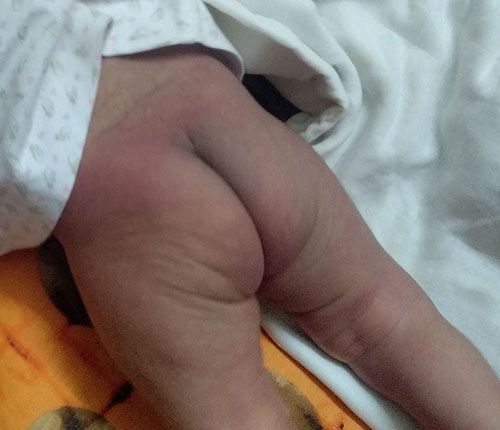A 10-day-old neonate, on exclusive breast feeds, had acute dacrocystitis
appearing on day 6 of life. The neonate was managed with topical
tobramycin drops, injectable cefotaxime and amikacin for two days and
then switched to oral syrup amoxicillin-clavulanic acid as the eye
condition improved. Two days after starting the oral antibiotic, the
neonate developed macular rash involving gluteal region and symmetric
maculo-papular rash involving flexures of elbow and axilla as in
Fig. 1 (a & b). A diagnosis of symmetrical
drug-related intertriginous and flexural exanthema (SDRIFE) was made,
based on the typical morphology and incriminating drug history. The drug
was stopped, and rash improved over the next two days. Naranjo algorithm
- adverse drug reaction (ADR) probability scale score was 5, and ADR was
labelled as probable.

(a) |

(b) |
|
Fig.1 (a) Maculopapular rash involving
flexures of elbow and axilla; (b) Macular rash in gluteal
region.
|
SDRIFE, also called Baboon syndrome, is a benign,
self-limiting symmetrical erythematous rash on the flexures after
systemic exposure to a drug, regardless of prior sensitization. It is
diagnosed by the following criteria: exposure to a systemically
administered drug either for the first time or repeat exposure
(excluding contact allergens), sharply demarcated erythema of the
gluteal/perianal area and/or V-shaped erythema of the inguinal/peri
genital area, involvement of at least one other intertriginous/flexural
localization, symmetry of the affected areas and absence of systemic
symptoms and signs. Among all the drugs known to cause this condi-tion,
the most common is amoxicillin, which our patient received. The other
drugs known to cause SDRIFE are pseudoephedrine, codeine, cimetidine,
nystatin, fluco-nazole, monoclonal antibodies, and radio contrast media.
The differential diagnosis includes conditions like allergic contact
dermatitis, drug reaction with eosinophilia and systemic symptoms
(DRESS), seborrheic dermatitis, inter-trigo, inverse psoriasis, granular
parakeratosis, Darier disease, Hailey-Hailey disease and acute
generalized exanthematous pustulosis (AGEP). Prognosis of SDRIFE is
generally good and the rash disappears after discontinuation of the
offending drug. SDRIFE is an uncommon rash in neonates but the
characteristic morphology clinches the clinical diagnosis.

